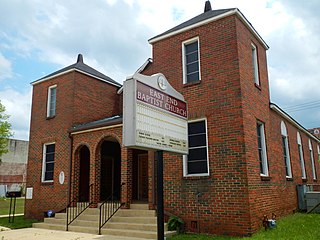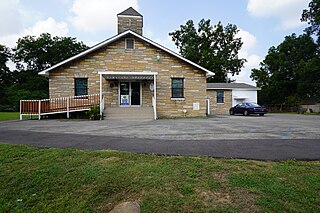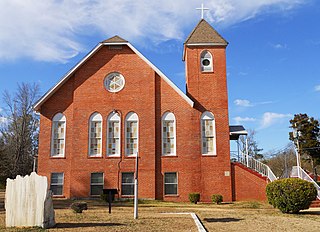
The 16th Street Baptist Church is a Baptist church in Birmingham, Alabama, United States. In 1963, the church was bombed by Ku Klux Klan members. The bombing killed four young girls in the midst of the Civil Rights Movement. The church is still in operation and is a central landmark in the Birmingham Civil Rights District. It was designated as a National Historic Landmark in 2006. Since 2008, it has also been on the UNESCO list of tentative World Heritage Sites.

The Birmingham Civil Rights District is an area of downtown Birmingham, Alabama where several significant events in the Civil Rights Movement of the 1950s and 1960s took place. The district was designated by the City of Birmingham in 1992 and covers a six-block area.

The Mount Zion AME Church is a historic church in Jacksonville, Florida, United States. It is located at 201 East Beaver Street. On December 30, 1992, it was added to the U.S. National Register of Historic Places. The "AME" is an abbreviation of African Methodist Episcopal, the religious denomination.

The Mount Zion African Methodist Episcopal Zion Church, also known as the Mount Zion AME Zion Church Memorial Annex, is a historic church in Montgomery, Alabama, United States. Located on 467 Holt Street, it was built in 1899 and extensively remodeled in 1921.

Sardis Baptist Church in Birmingham, Alabama, also known as Old Sardis Baptist Church was built around 1910. The church as the location where the Alabama Christian Movement for Human Rights was created at a mass meeting of over 1,000 people on June 5, 1956. Its pastor, the Reverend Robert L. Alford, was one of the founders of the organization. The church building was listed on the National Register of Historic Places in 2005.

St. James AME Zion Church is a historic African Methodist Episcopal Zion church located at Ithaca in Tompkins County, New York. It is a two-story, frame church structure set on a high foundation and featuring a four-story entrance tower. The church structure was begun in the 1830s and modified many times since. The original stone meetinghouse was built in 1836 and is believed to be Ithaca's oldest church and one of the oldest in the AME Zion system.

Smith Metropolitan AME Zion Church is a historic African Methodist Episcopal Zion Church located at Smith and Cottage Streets in Poughkeepsie, Dutchess County, New York. It is the oldest predominantly African-American church in Dutchess County, NY. The church was a part of The Underground Railroad led by Civil Rights leader Harriet Tubman. The first black female judge in America, Ms. Jane Bolin, was a member of this church, along with other influential people. The church has experienced phenomenal new growth under the leadership of their Pastor, Reverend Edwrin Sutton. The Church as a ministry began in 1836. The church building was built between 1908 and 1910, with the parsonage added in 1914. The one-story, rectangular Gothic Revival church has an attached two-story bell tower topped by a pyramidal roof and a raised basement. The brick building features pointed arched openings and stained glass windows.

Wesley A.M.E. Zion Church is an historic church, which is located at 1500 Lombard Street in Philadelphia, Pennsylvania. Added to the National Register of Historic Places in 1978, it also appears in the Philadelphia Register of Historic Places and the Pennsylvania State Historic Resource survey.

Twin Beech AME Zion Church, listed as Twin Beach AME Church, is a historic African Methodist Episcopal church on the east side of CR 44 in Fairhope, Alabama. It was built in 1925 and added to the National Register of Historic Places in 1988.

East End Baptist Church is a historic Baptist church building at 2609 Sixth Avenue South in Birmingham, Alabama. It was built in 1947 in a style that can be described as Romanesque Revival, but has been well described by Jay Price as mid-century traditional. It added to the National Register of Historic Places in 2005. During the Civil Rights Movement it was led by the Reverend Calvin W. Woods.

First Baptist Church, Kingston is a historic church at 4600 Ninth Avenue North in Birmingham, Alabama. It was built in 1961 and added to the National Register of Historic Places in 2005. The congregation was organized in 1930, it was led by George W. Dickerson from 1941 to 1972, it played a leading role in the Civil Rights Movement and served as a site for mass meetings held by the Alabama Christian Movement for Human Rights. The church is now surrounded by a public housing project erected in the late 1950s.

First Ebenezer Baptist Church is a historic Baptist church at 420 Graymont Avenue North in Smithfield in Birmingham, Alabama. It was built in 1963 and the congregation was active in the 1960s Civil Rights Movement. The church was added to the National Register of Historic Places in 2005. This church serves Jefferson County.
Mount Ararat Baptist Church is a historic church at 1920 Slayden Avenue, Ensley in Birmingham, Alabama. It is located in the Ensley suburb, west of downtown Birmingham, and overlooks Highway 239. It was originally built in 1929 but was modified in 1950 to add a red brick veneer.
The Peace Baptist Church is a church at 302 Sixth Street North in Birmingham, Alabama. Its historic building was added to the National Register of Historic Places in 2005. It was deemed significant for its association in 1963 with the Birmingham civil rights movement. The historic building, which had become a fellowship hall for a new church building built in 1970, has since been demolished.

St. Luke AME Church is a historic African Methodist Episcopal church at 2803 21st Avenue North in Birmingham, Alabama. It was designed by the pioneering African American Architect Wallace Rayfield. It was built in 1926 and added to the National Register of Historic Places in 2005. The church was significant in the civil rights movement.

Shady Grove Baptist Church is a historic church at 3444 31st Way North, Collegeville in Birmingham, Alabama. The building is of concrete construction that was built in 1942 under the direct of its pastor, the Rev. Lewis J. Rogers. The exterior was faced with Permastone in the early 1960s. It is significant for its congregation's participation in the Alabama Christian Movement for Human Rights rallies for Civil rights in the 1950s and the 1960s under Rogers' direction. The building was added to the National Register of Historic Places in 2005.

West End Hills Missionary Baptist Church is a historic church at 1680 19th Place SW in Birmingham, Alabama. It was built between 1959 and 1965 when the main sanctuary was dedicated. The church is significant for its congregation's participation in the Alabama Christian Movement for Human Rights rallies for Civil rights in the 1950s and the 1960s under the direction of its pastor, the Rev. Coleman M. Smith. It was added to the National Register of Historic Places in 2005.

Canaan Baptist Church is a Baptist church located in Bessemer, Alabama. It is affiliated with the National Baptist Convention, USA. Built in 1961, it had a congregation active in the Civil Rights Movement of the 20th century and was added to the National Register of Historic Places in 2005.

Butler Chapel African Methodist Episcopal Zion Church is a historic church at 1002 N. Church Street in Tuskegee, Alabama. Built in 1957, it was added to the Alabama Register of Landmarks and Heritage in 1985 and the National Register of Historic Places in 1995. It was an important location associated with the civil rights movement of the 1950s and '60s.






















